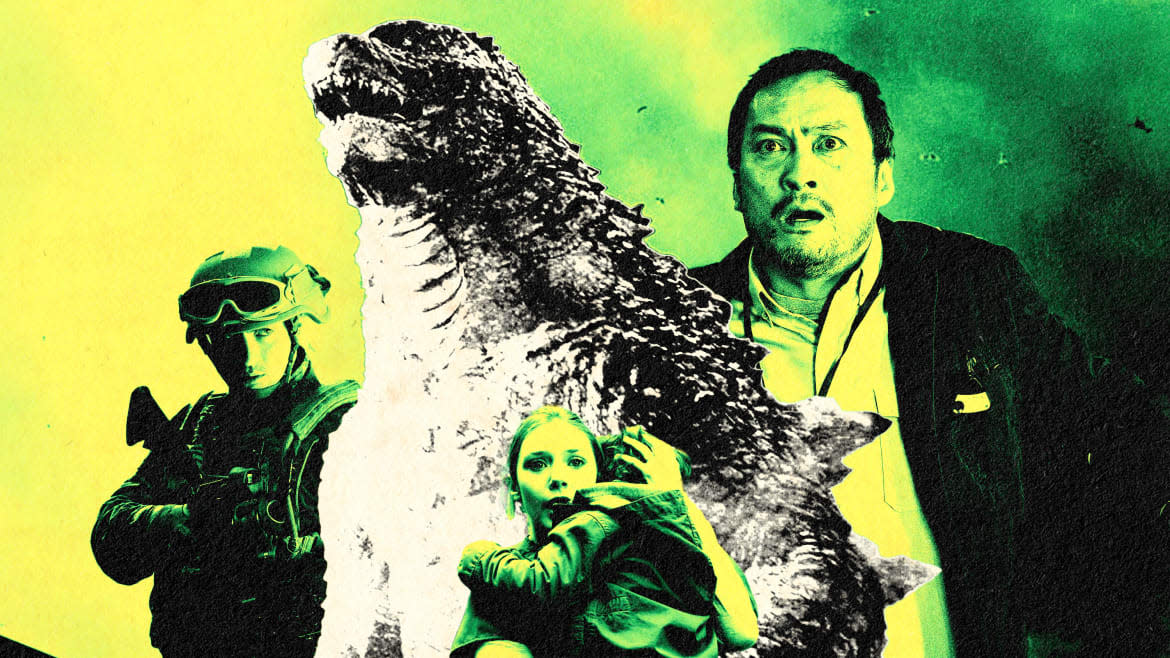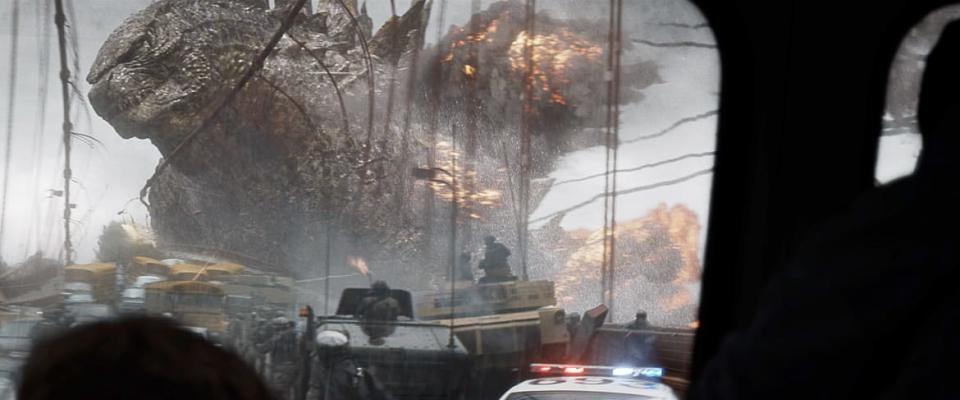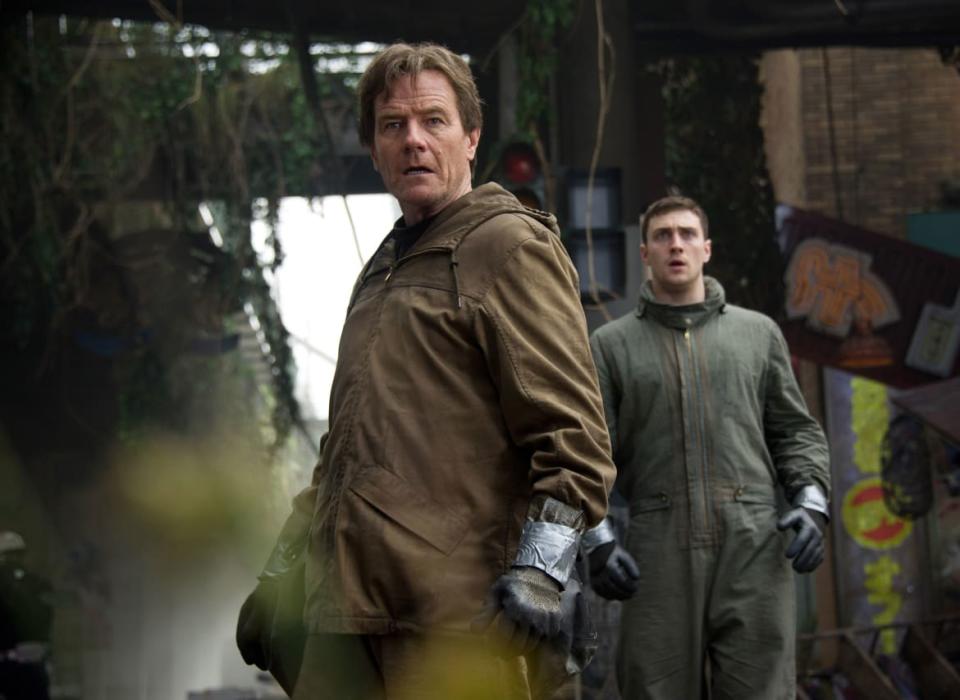Even Without Much Godzilla, the 2014 ‘Godzilla’ Still Rules

- Oops!Something went wrong.Please try again later.
- Oops!Something went wrong.Please try again later.
It took 70 years, but Godzilla finally has an Oscar. The big guy’s latest rampage, Godzilla Minus One, picked up Best Visual Effects at the 96th Academy Awards a few weeks ago—a long-overdue honor for a movie monster who’s been wreaking resourceful, frugally realized mayhem since the days when he was still a stuntman trampling model cities. Incidentally, one of the movies Minus One beat was The Creator, a lavish sci-fi epic from writer-director Gareth Edwards. Something tells us that Edwards didn’t take the loss too hard. After all, he’s had nothing but nice things to say about the film that bested his own. “It’s what a Godzilla movie should be,” he gushed in a recent interview.
Edwards should know: He, too, has made a Godzilla movie. That movie, titled simply Godzilla, was released 10 years ago this May. A box office success, it did what Roland Emmerich couldn’t and finally ushered the skyscraping Japanese star into an ongoing Hollywood franchise. Multiple sequels have followed; the latest, Godzilla x Kong: The New Empire, stomps into multiplexes this Friday. The series has even expanded into television via an Apple TV+ spinoff set before, during, and after the events of the monster movie that inspired it.
For all the groundwork it’s laid, the 2014 Godzilla occupies an unusual place in the oeuvre of everyone’s favorite radioactive reptile. It’s not nearly as acclaimed as its recent Japanese cousins, Minus One and 2016’s satirical Shin Godzilla. (Fans from that side of the world had a field day, in fact, with the portliness of the creature design, joking that of course an American take on the G-man would be fatter.) And even within its own so-called MonsterVerse, Edwards’ hit now looks like something of an outlier: In response to complaints that there wasn’t enough Godzilla in his Godzilla movie—a reservation echoed by a recent Variety ranking of the entire canon—the sequels have offered much more kaiju bang for your buck, as if apologizing for their own ground zero.

And yet none of those movies possesses a fraction of the spooky majesty Edwards brought to his. Nor, for that matter, do many of the Hollywood event pictures released since. (The Dune movies are one exception. Rogue One, which Edwards also directed, is another.) Godzilla ’14 is IMAX spectacle par excellence—a truly state-of-the-art kaiju movie that puts every penny up there on screen, funneling its resources into the kind of genuinely striking imagery that largely went dormant during the age of Kevin Feige. No, there isn’t that much Godzilla in the film. But even the scenes without him can leave you breathless.
Edwards, a former effects artist, is the rare filmmaker of his budget class with a real sense of scale. Maybe his career path from tiny to enormous productions instilled in him an appreciation for contrast. Either way, he knows how to make something big look even bigger by putting it next to something small. He stages much of Godzilla from a decidedly human vantage, emphasizing the enormity of his prehistoric attractions by catching them from ground level. That strategy extends to the narrative, too, which follows a single soldier (Aaron Taylor-Johnson) across the vast landscape of a global armed-forces operation scrambling to respond to the emergence of world-ending monsters.
‘Godzilla Minus One’ Brings All the Mayhem and Destruction You Crave
Like Emmerich, who populated his dismally received 1998 Godzilla with leaping raptor wannabes, Edwards often seems more indebted to Steven Spielberg than Toho. Look at how his Godzilla opens: After a nifty opening credits sequence, a helicopter cuts across an expanse of verdant land as if headed for Isla Nubar. Later, pens rolling off a table make like a cup of rippling water and announce the approach of something massive. (No wonder Edwards has been tapped to direct the next Jurassic Park.) Elsewhere, there’s a little Close Encounters to the scenes of military mobilization. And the whole decision to keep Godzilla offscreen for long stretches, building suspense from his absence, recalls the strategic infrequency of the shark attacks in Jaws.
If the film’s games of anticipation should make the Amblin master proud, its broken-family drama is similarly Spielbergian, if not quite as soulful. Most of its emotional power rests on Bryan Cranston, fresh off Breaking Bad and never once betraying the faintest hint that he treated his small role as a bereaved scientist like an easy paycheck. Quite to the contrary, he pumps the movie’s largely monster-free opening half-hour with anguished feeling: bellowing at government bigwigs; mournfully sifting through the rubble of an abandoned family home, in an accidental echo of the Breaking Bad finale; tearfully saying goodbye to his doomed wife. As with Godzilla himself, there’s not a lot of Cranston in the movie. But he makes such a forceful impression across his handful of scenes that the trailers leaned heavily on his performance.
The margins of the movie are packed with great actors in mostly functional supporting roles, including Juliette Binoche, Elizabeth Olsen, David Strathairn, Sally Hawkins, and Ken Watanabe. The weakest link of the cast is actually its leading man, Johnson, who plays a kind of blandly driven grunt. It’s possible to read Godzilla as a therapeutic odyssey—the tale of one man outrunning his past, with the skyscraper-sized beasts a manifestation of the generational trauma threatening to consume his new life as a father and husband. But for that aspect to really land, it would have needed to either be further developed or scrawled across the features of a more expressive star. (Seriously, this guy is going to take over for Daniel Craig?) The lack of any truly involving human drama à la Minus One is all that really holds the movie back.

Then again, maybe Edwards is aiming for something beyond traditional human drama, something more mythic, even biblical. Film critic David Ehrlich called Godzilla “the first post-human blockbuster” and, indeed, its doomsday dread hinges on a vision of forces beyond the control of our species: While Johnson’s dogged marine plays his own crucial role in the climax, helping save the day in the vast shadow of warring titans, the fate of humanity mostly rests on which ancient alpha predator will come out on top. Most of the characters are mere spectators, no more capable than we in the audience are of altering the course of events.
A sense of almost helpless astonishment is what drives this Godzilla—and what connects it to Ishirō Honda’s more blatantly allegorical 1954 original. Many of the major set-pieces strand viewers and characters alike in the blast radius of enormous enemies, catching the carnage from the windows of a gridlocked school bus or reflected in the helmet of a paratrooper. Edwards, integrating then-cutting-edge CGI with ace location shooting, offers one casually amazing image of end-time destruction after another: a totaled airplane blocking the highway for miles; fighter jets falling like asteroids from the sky after an EMP; once-mighty buildings blown halfway to Hell.
‘Godzilla vs. Kong’ Is Big, Dumb, City-Destroying Fun
As pure spectacle, the movie arguably peaks at the half, when the action shifts to Honolulu and Godzilla finally rises from the ocean to take on the first of his two insectoid rivals. The scene is a thrilling piece of cross-cutting terror, somehow delivering the city-go-boom goods—like a train careening towards a giant bug blocking the track or an oceanfront boulevard engulfed by the tsunami created by an emerging leviathan—while still offering only fleeting, teasing glimpses of the headliner. The coup de grace, though, is the prankish way Edwards ends the sequence. Right as the monsters come face to face, he cuts to a television set in another city, and a small boy watching the battle play out from a great distance, voyeuristically captured by news cameras.
It’s a brilliant subversion of expectations. Edwards isn’t just reinforcing his notion of Armageddon as it would play out from the inconsistent, sometimes limited perspective of civilians. (Wouldn’t most of us see it on television, right up until the moment when one of the monsters stepped on our house?) He’s also, well, edging the audience before the climax—teasing us with little glimmers of monster mayhem to build our itchy, desperate desire for the big showdown. Fortunately, the finale delivers: Nothing in the less-withholding sequels can match the fist-pump satisfaction of Godzilla’s nuclear kiss of death.
Still, it’s not difficult to understand why this Godzilla proved divisive. That keep-away approach was bound to irk diehards and casual destruction junkies alike. Stopwatches clock Godzilla’s screen time somewhere around 10 minutes total—practically a cameo for this lumbering, roaring weapon of mass destruction. No wonder the franchise tacked in the opposite direction, maximizing our view of the titanic tussles (albeit while still sometimes obscuring them with smoke, snow, or dodgy CGI). That Godzilla: King of the Monsters and the two King Kong crossovers that followed would ditch Edwards’ sparing approach to kaiju combat was inevitable. One might still wish they didn’t also abandon his way with perspective and proportion; the staggering size of these imaginary monsters gets lost when they’re filmed straight on like pro wrestlers instead of from cowering distance.
Anyway, what the Edwards Godzilla lacks in nonstop monster action, it makes up for in atmosphere, casual visual elegance, and the heft the director lends his globe-hopping material, even in its moments of quiet before the next screeching metropolitan assault. It’s among the most impressively huge visions to come out of the studio system this new century, and one of the most inventive. And if that’s not what a Godzilla movie should be, it’s certainly what a blockbuster should.
Get the Daily Beast's biggest scoops and scandals delivered right to your inbox. Sign up now.
Stay informed and gain unlimited access to the Daily Beast's unmatched reporting. Subscribe now.

